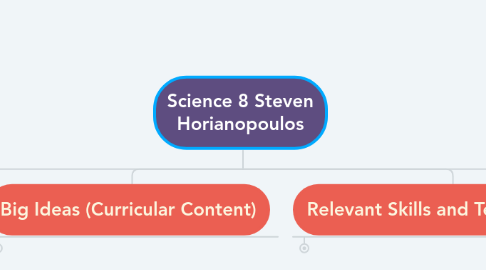
1. Big Ideas (Curricular Content)
1.1. The following can be considered some "guiding" ideas for project design based on the Big Ideas of Science 8 curriculum
1.2. Life processes are performed at the cellular level
1.2.1. Eukaryotic cells contain many different organelles which work together to keep the cell - and therefore the body - going. Consider other systems in life that rely on many different parts to work properly. Can you use the organelle/cell system to inspire a new way to design a current system in regular human life (eg. food distribution, factories, traffic, etc)
1.3. Behaviour of matter can be explained by the kinetic molecular theory (KMT) and atomic theory
1.3.1. Design and implement an experiment that shows off the KMT. Use clear independent and dependent variables to show changes in movement.
1.4. Energy can be transferred as a particle and a wave
1.4.1. "History" Project: Research an old light experiment from history and try to recreate it using modern tools,
1.5. Plate tectonics is the unifying theory that explains Earth's geological processes
1.5.1. What interests you most about plate tectonics? Address an issue that is related to plate tectonics and design a deliverable (brochure, pamphlet, video, etc) to raise awareness or advertise it.
2. Assessment
2.1. Assessment in this class would based on project research and design more so than implementation, with a focus on students exploring their own questions rather than them successfully completing a design
2.2. Research and Development
2.2.1. Approaching: Research is irrelevant to topic or severely lacking. Project design does not display student learning.
2.2.2. Meeting: Research is relevant and robust. Student shows understanding of topic through the project design and implementation.
2.3. Safety and Procedure
2.3.1. Approaching: Student did not design in a way that respects physical, mental, and cultural safety, and did not make their design easily replicable.
2.3.2. Meeting: Student considered safety of self and others in project design, and laid out thinking and experimentation in a way that can be followed and repeated.
2.4. Planning and Predicting
2.4.1. Approaching: Student did not attempt to make observations or identify problems to solve. No predictions were made before designing and implementing project.
2.4.2. Meeting: Student thoughtfully considered problems associated with topic and chose project accordingly. Student made clear predictions before undergoing experimentation.
2.5. ADST Component
2.5.1. Approaching: Student did not attempt to use applied skills or technologies in project design, or if they did they were not implemented purposefully.
2.5.2. Meeting: Student designed project to be done with applied skills and technologies in mind, using resources available to them appropriately.
3. Problems (and solutions)
3.1. Grade 8 classrooms are extremely diverse and many students may not have direct passion for the subject matter at hand
3.1.1. Along with discussions to decide on design projects (empathetic design), give more guided ideas for big idea projects so all students can feel included
3.2. Abilities and skills required to undertake larger projects may not be something that many students are equipped with
3.2.1. Allow students to decide on scale of project with an understanding that big and flashy projects are no better than humble ones; learning should be at the centre of any project and that is the main criteria
3.3. Combination of transition to high school setting and more autonomy in learning can be difficult for students
3.3.1. Empathy in assessment understands that learning is the key point of education, and growth comes when students have to step outside of their comfort zone a bit
3.4. Students (and teachers) can find it difficult to consider Indigenous perspectives in Science classes
3.4.1. Consultation with the FPPL allows us to understand how any project is connected to Indigenous history, culture, and ways of knowing
